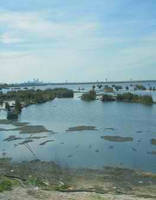Coastal Monitoring Using a Custom DAQ Solution

System Control and Data Acquisition from CAS DataLoggers
CHESTERLAND OH - CAS DataLoggers recently developed a custom measuring process for a large county's environmental department to acquire data on the wave run-up at a local levee as part of the county's 2010 general plan for coastal protection. The department needed to develop a new measurement system for wave run-up because no suitable system existed on the market. The safety of the levees needed to be monitored at regular intervals along with other important measurement parameters including sea depth, sea condition and wave run-up, especially during storm surges. To determine such parameters, extensive field measurements were necessary, which required a real-time system with remote monitoring and data transfer capabilities.
A single, flexible unit was used as the measurement, control, and storage device, based on a Delphin Technologies data acquisition system. A new process was developed and subjected to extensive laboratory trials prior to the installation, while a new procedure was also designed for safety monitoring and measurement of the levees.
Measurement stations were operated by county workers at selected sites along the region's west coast to measure sea conditions, tidal flows and wave run-up. These stations were positioned about 150 ft. apart and were equipped with flow meters and pressure sensors positioned at the foot of the levees. The flow meters functioned according to the electromagnetic measurement principle with a measurement range of-5 to +5 m/s. The pressure sensors were used for determining sea conditions and sea depth using the piezoresistive measurement principle. Special sea cables were laid for power supply and data transmission.
Aluminium carrier plates were laid on the levee's outer banks, equipped with stainless steel, individually- addressed measurement sensors sorted into pairs at distances of around 30 cm. A sensor resistor was connected parallel to the measurement electrodes. The resistor had a dual pole sensor lead providing the Rx total resistance of a measuring bridge, enabling detection of broken wire and short circuit occurrences. Differing conductivities occurred between the measurement sensors depending on the properties of the electrolyte (rain, flotsam, spray, wave run-up). The bridge voltage was cyclically (10Hz) recorded analog to the occurrence of the different conductivities.
Preliminary trials using a wave channel established conductivity limit values for the various mediums (fresh water, sea water, etc.) and up to 70 pairs of measurement sensors were installed to cover the whole of the levee banks. A virtual calculation channel was then allocated to each of the 70 input channels--this channel use limited values and elevation to determine whether a wave run-up had occurred. A further calculation channel established the highest measurement sensor detecting a wave
run-up. This procedure then made it possible to determine the wave run-up at a high degree of accuracy.
Recording the storm surge was a time-sensitive process: wave run-up onto the levees only occurred during high surge sea levels, so the project measurement and recording were dependent upon local sea levels and wave depths. The pressure sensors installed at the foot of the levee provided the data and trigger information operators required. Measurement data was then recorded only when it was necessary, avoiding any redundant acquisition of data in calm conditions.
Despite this intelligent method of acquiring and recording data, a large amount of data still needed to be processed. With this in mind, the measurement device used was equipped with a robust 1GB storage capability which ensured data security and provided the required storage space. In this way, operators could record at the required temporal resolution for the entire duration of the event.
To guarantee that data acquisition continued when a power failure occurred (a likely occurrence in the event of a storm surge), the entire data acquisition system was equipped with a battery backup system. This data acquisition device could also operate autarchically, requiring no PC support. The top-hat rail devices, measuring at just 200mm, were installed into compact switch cabinets at each measurement station.
Remote data transfer capability was also necessary because the devices were located at various measurement stations. Two serial ports on the device enabled direct connection to analog, ISDN or GSM modems. Data was then transmitted directly to the department's headquarters during an event without requiring onsite manual readout of the devices.
Operators used the user-friendly Delphin ProfiSignal software to evaluate the data acquired during an event, while an intelligent Dataservice processed the information using a PC. Operators could zoom onscreen within seconds of an event or each individual wave to analyze the measurement data, which could then be evaluated both online and offline. A toolbar and intuitive software aided these functions. Measurement data requiring additional evaluation was then exported in ASCII or CSV format.
The department's coastal monitoring project benefited in several ways from installing the customized Delphin data acquisition system. The system monitored all the necessary parameters at extremely high accuracy and also processed all the data. Throughout the project, the device's battery backup and autarchic operation provided reliable operation. Additionally, ProfiSignal's evaluation function enabled the department to continue using their existing evaluation software.
For more information on real-time Delphin data acquisition systems, or to find the ideal solution for your application-specific needs, contact a CAS Data Logger Applications Specialist at (800) 956-4437 or visit the website at www.DataLoggerInc.com.
Contact Information:
CAS DataLoggers, Inc.
12628 Chillicothe Road
Chesterland, Ohio 44026
(440) 729-2570
(800) 956-4437
sales@dataloggerinc.com
http://www.dataloggerinc.com




